check engine INFINITI QX55 2023 Repair Manual
[x] Cancel search | Manufacturer: INFINITI, Model Year: 2023, Model line: QX55, Model: INFINITI QX55 2023Pages: 526, PDF Size: 5.75 MB
Page 390 of 526

The chassis control is an electric control mod-
ule that includes the following functions:
• Active Trace Control
• Active Engine Brake
• Active Ride Control
ACTIVE TRACE CONTROL
The Active Trace Control senses driving
based on the driver’s steering and
acceleration/braking patterns, and controls
brake pressure at individual wheels to aid
tracing at corners and help smooth vehicle
response.
When the lower display is used to turn off the
VDC system, the Active Trace Control sys-
tem is also turned off.
When the PERSONAL mode is selected, the
Active Trace Control can be set to ON (en-
abled) or OFF (disabled). For additional infor-
mation, see “INFINITI Drive Mode Selector”
(P. 5-29).When the Active Trace Control is operated
and the “Chassis Control” mode is selected in
the vehicle information display, the Active
Trace Control graphics are shown in the ve-
hicle information display. For additional in-
formation, see “Vehicle information display”
(P. 2-19).
If the chassis control warning message ap-
pears in the vehicle information display, it
may indicate that the Active Trace Control is
not functioning properly. Have the system
checked as soon as possible. It is recom-
mended that you visit an INFINITI retailer for
this service.
WARNING
The Active Trace Control may not be effec-
tive depending on the driving condition. Al-
ways drive carefully and attentively.
When the Active Trace Control is operating,
you may feel a pulsation in the brake pedal
and hear a noise. This is normal and indicates
that the Active Trace Control is operating
properly.
You may also feel deceleration when the Ac-
tive Trace Control is operating. However, this
is not a malfunction.
LSD4774
CHASSIS CONTROL
5-144Starting and driving
Page 391 of 526
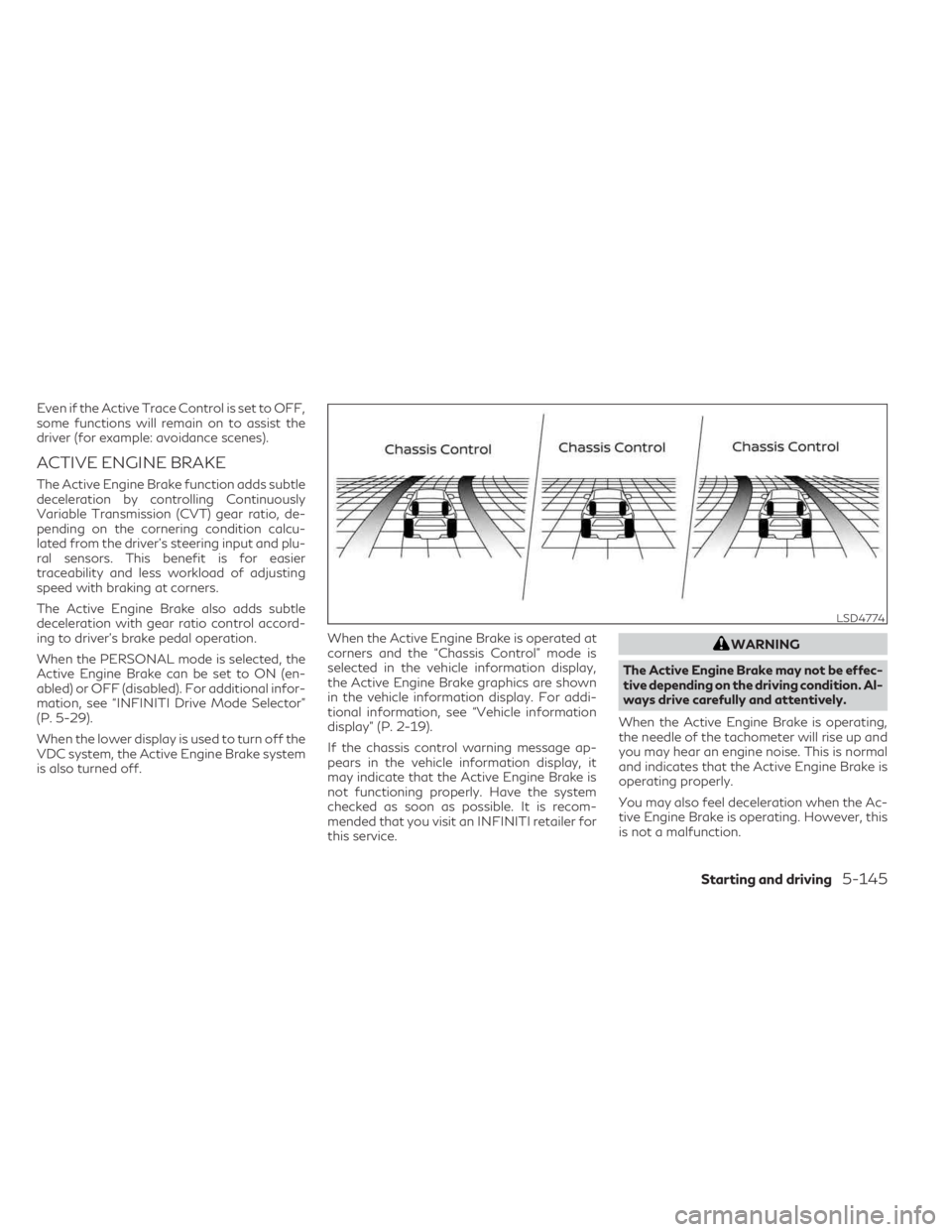
Even if the Active Trace Control is set to OFF,
some functions will remain on to assist the
driver (for example: avoidance scenes).
ACTIVE ENGINE BRAKE
The Active Engine Brake function adds subtle
deceleration by controlling Continuously
Variable Transmission (CVT) gear ratio, de-
pending on the cornering condition calcu-
lated from the driver's steering input and plu-
ral sensors. This benefit is for easier
traceability and less workload of adjusting
speed with braking at corners.
The Active Engine Brake also adds subtle
deceleration with gear ratio control accord-
ing to driver’s brake pedal operation.
When the PERSONAL mode is selected, the
Active Engine Brake can be set to ON (en-
abled) or OFF (disabled). For additional infor-
mation, see “INFINITI Drive Mode Selector”
(P. 5-29).
When the lower display is used to turn off the
VDC system, the Active Engine Brake system
is also turned off.When the Active Engine Brake is operated at
corners and the “Chassis Control” mode is
selected in the vehicle information display,
the Active Engine Brake graphics are shown
in the vehicle information display. For addi-
tional information, see “Vehicle information
display” (P. 2-19).
If the chassis control warning message ap-
pears in the vehicle information display, it
may indicate that the Active Engine Brake is
not functioning properly. Have the system
checked as soon as possible. It is recom-
mended that you visit an INFINITI retailer for
this service.
WARNING
The Active Engine Brake may not be effec-
tive depending on the driving condition. Al-
ways drive carefully and attentively.
When the Active Engine Brake is operating,
the needle of the tachometer will rise up and
you may hear an engine noise. This is normal
and indicates that the Active Engine Brake is
operating properly.
You may also feel deceleration when the Ac-
tive Engine Brake is operating. However, this
is not a malfunction.
LSD4774
Starting and driving5-145
Page 399 of 526
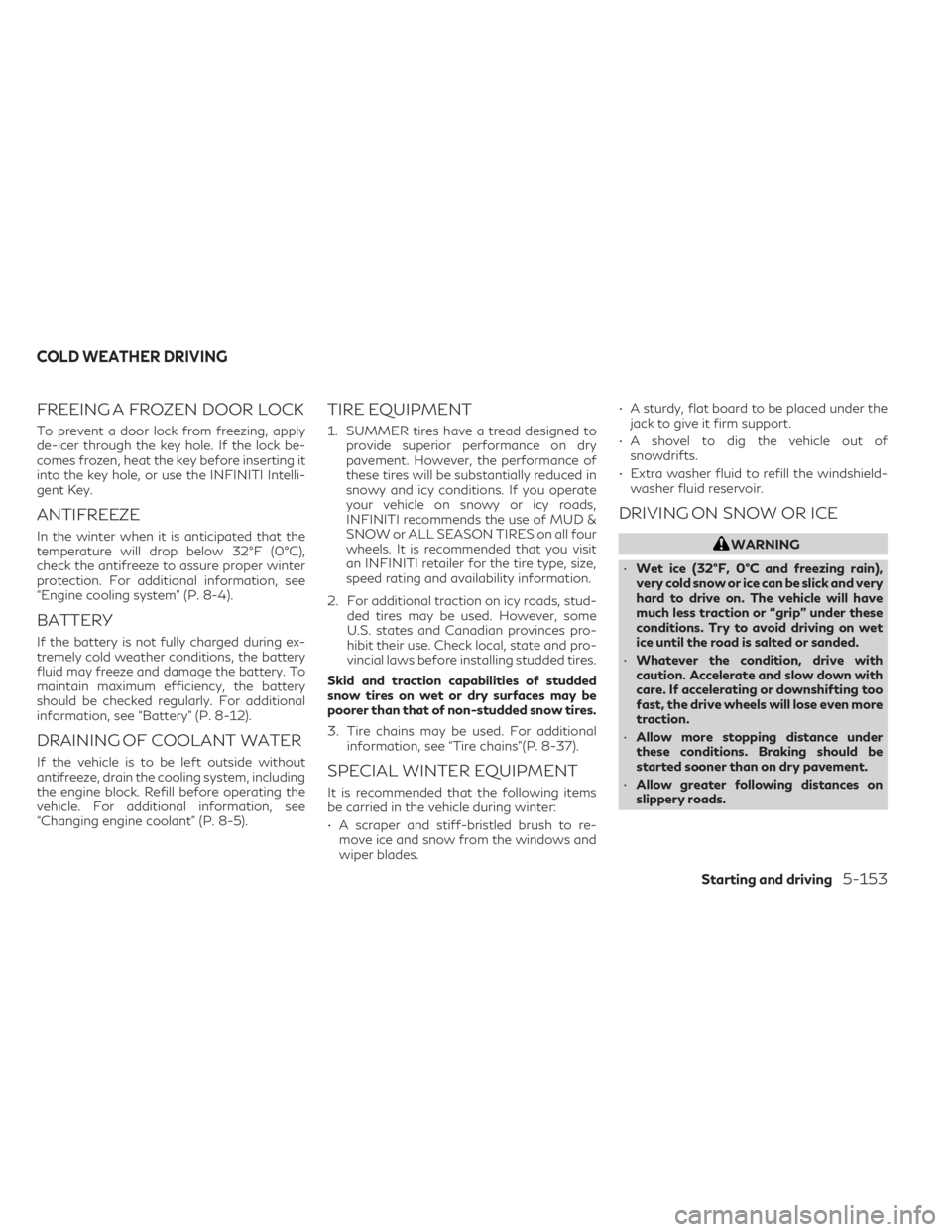
FREEING A FROZEN DOOR LOCK
To prevent a door lock from freezing, apply
de-icer through the key hole. If the lock be-
comes frozen, heat the key before inserting it
into the key hole, or use the INFINITI Intelli-
gent Key.
ANTIFREEZE
In the winter when it is anticipated that the
temperature will drop below 32°F (0°C),
check the antifreeze to assure proper winter
protection. For additional information, see
“Engine cooling system” (P. 8-4).
BATTERY
If the battery is not fully charged during ex-
tremely cold weather conditions, the battery
fluid may freeze and damage the battery. To
maintain maximum efficiency, the battery
should be checked regularly. For additional
information, see “Battery” (P. 8-12).
DRAINING OF COOLANT WATER
If the vehicle is to be left outside without
antifreeze, drain the cooling system, including
the engine block. Refill before operating the
vehicle. For additional information, see
“Changing engine coolant” (P. 8-5).
TIRE EQUIPMENT
1. SUMMER tires have a tread designed toprovide superior performance on dry
pavement. However, the performance of
these tires will be substantially reduced in
snowy and icy conditions. If you operate
your vehicle on snowy or icy roads,
INFINITI recommends the use of MUD &
SNOW or ALL SEASON TIRES on all four
wheels. It is recommended that you visit
an INFINITI retailer for the tire type, size,
speed rating and availability information.
2. For additional traction on icy roads, stud- ded tires may be used. However, some
U.S. states and Canadian provinces pro-
hibit their use. Check local, state and pro-
vincial laws before installing studded tires.
Skid and traction capabilities of studded
snow tires on wet or dry surfaces may be
poorer than that of non-studded snow tires.
3. Tire chains may be used. For additional information, see “Tire chains”(P. 8-37).
SPECIAL WINTER EQUIPMENT
It is recommended that the following items
be carried in the vehicle during winter:
• A scraper and stiff-bristled brush to re-move ice and snow from the windows and
wiper blades. • A sturdy, flat board to be placed under the
jack to give it firm support.
• A shovel to dig the vehicle out of snowdrifts.
• Extra washer fluid to refill the windshield- washer fluid reservoir.
DRIVING ON SNOW OR ICE
WARNING
• Wet ice (32°F, 0°C and freezing rain),
very cold snow or ice can be slick and very
hard to drive on. The vehicle will have
much less traction or “grip” under these
conditions. Try to avoid driving on wet
ice until the road is salted or sanded.
• Whatever the condition, drive with
caution. Accelerate and slow down with
care. If accelerating or downshifting too
fast, the drive wheels will lose even more
traction.
• Allow more stopping distance under
these conditions. Braking should be
started sooner than on dry pavement.
• Allow greater following distances on
slippery roads.
COLD WEATHER DRIVING
Starting and driving5-153
Page 405 of 526
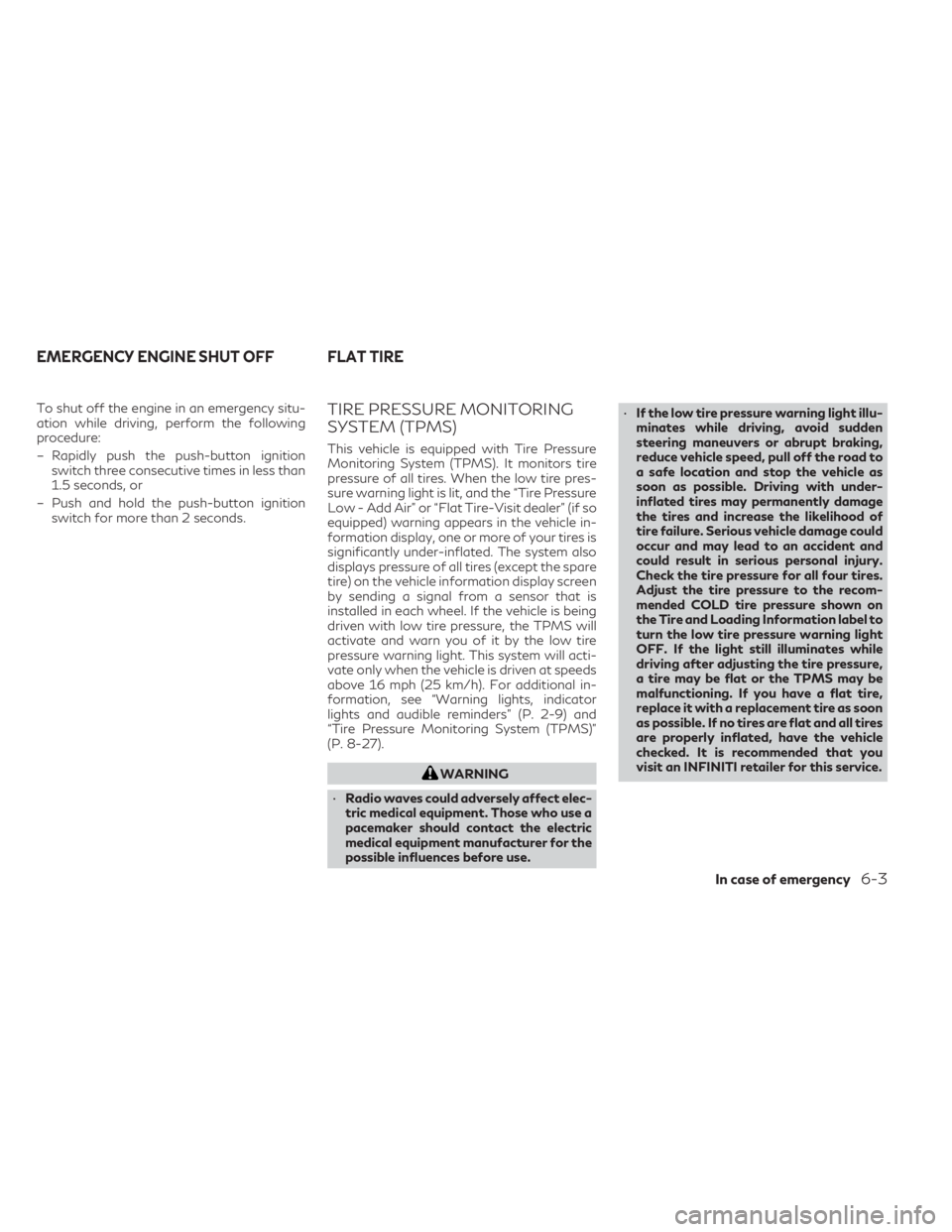
To shut off the engine in an emergency situ-
ation while driving, perform the following
procedure:
– Rapidly push the push-button ignitionswitch three consecutive times in less than
1.5 seconds, or
– Push and hold the push-button ignition switch for more than 2 seconds.TIRE PRESSURE MONITORING
SYSTEM (TPMS)
This vehicle is equipped with Tire Pressure
Monitoring System (TPMS). It monitors tire
pressure of all tires. When the low tire pres-
sure warning light is lit, and the “Tire Pressure
Low - Add Air” or “Flat Tire-Visit dealer” (if so
equipped) warning appears in the vehicle in-
formation display, one or more of your tires is
significantly under-inflated. The system also
displays pressure of all tires (except the spare
tire) on the vehicle information display screen
by sending a signal from a sensor that is
installed in each wheel. If the vehicle is being
driven with low tire pressure, the TPMS will
activate and warn you of it by the low tire
pressure warning light. This system will acti-
vate only when the vehicle is driven at speeds
above 16 mph (25 km/h). For additional in-
formation, see “Warning lights, indicator
lights and audible reminders” (P. 2-9) and
“Tire Pressure Monitoring System (TPMS)”
(P. 8-27).
WARNING
• Radio waves could adversely affect elec-
tric medical equipment. Those who use a
pacemaker should contact the electric
medical equipment manufacturer for the
possible influences before use. •
If the low tire pressure warning light illu-
minates while driving, avoid sudden
steering maneuvers or abrupt braking,
reduce vehicle speed, pull off the road to
a safe location and stop the vehicle as
soon as possible. Driving with under-
inflated tires may permanently damage
the tires and increase the likelihood of
tire failure. Serious vehicle damage could
occur and may lead to an accident and
could result in serious personal injury.
Check the tire pressure for all four tires.
Adjust the tire pressure to the recom-
mended COLD tire pressure shown on
the Tire and Loading Information label to
turn the low tire pressure warning light
OFF. If the light still illuminates while
driving after adjusting the tire pressure,
a tire may be flat or the TPMS may be
malfunctioning. If you have a flat tire,
replace it with a replacement tire as soon
as possible. If no tires are flat and all tires
are properly inflated, have the vehicle
checked. It is recommended that you
visit an INFINITI retailer for this service.
EMERGENCY ENGINE SHUT OFF FLAT TIRE
In case of emergency6-3
Page 409 of 526

CAUTION
• Continuously Variable Transmission
(CVT) models cannot be push-started or
tow-started. Attempting to do so may
cause transmission damage.
• Do not push start this vehicle. The three-
way catalyst may be damaged.WARNING
• Do not continue to drive if your vehicle
overheats. Doing so could cause engine
damage or a vehicle fire.
• To avoid the danger of being scalded,
never remove the coolant reservoir cap
while the engine is still hot. When the
coolant reservoir cap is removed, pres-
surized hot water will spurt out, possibly
causing serious injury.
• Do not open the hood if steam is coming
out.
If your vehicle is overheating (indicated by an
extremely high temperature gauge reading),
or if you feel a lack of engine power, detect
abnormal noise, etc. take the following steps.
1. Move the vehicle safely off the road, apply the parking brake and engage the P (Park)
position.
Do not stop the engine.
2. Turn off the air conditioner. Open all the windows, move the heater or air condi-
tioner temperature control to maximum
hot and fan control to high speed. 3. Get out of the vehicle. Look and listen for
steam or coolant escaping from the radia-
tor before opening the hood. (If steam or
coolant is escaping, turn off the engine.)
Do not open the hood further until no
steam or coolant can be seen.
4. Open the engine hood.
WARNING
If steam or water is coming from the en-
gine, stand clear to prevent getting
burned.
5. Visually check drive belts for damage or looseness. Also check if the cooling fan is
running. The radiator hoses and radiator
should not leak water. If coolant is leaking,
the water pump belt is missing or loose, or
the cooling fan does not run, stop the
engine.
WARNING
Be careful not to allow your hands, hair,
jewelry or clothing to come into contact
with, or get caught in, engine belts or the
engine cooling fan. The engine cooling fan
can start at any time.
PUSH STARTING IF YOUR VEHICLE OVERHEATS
In case of emergency6-7
Page 410 of 526
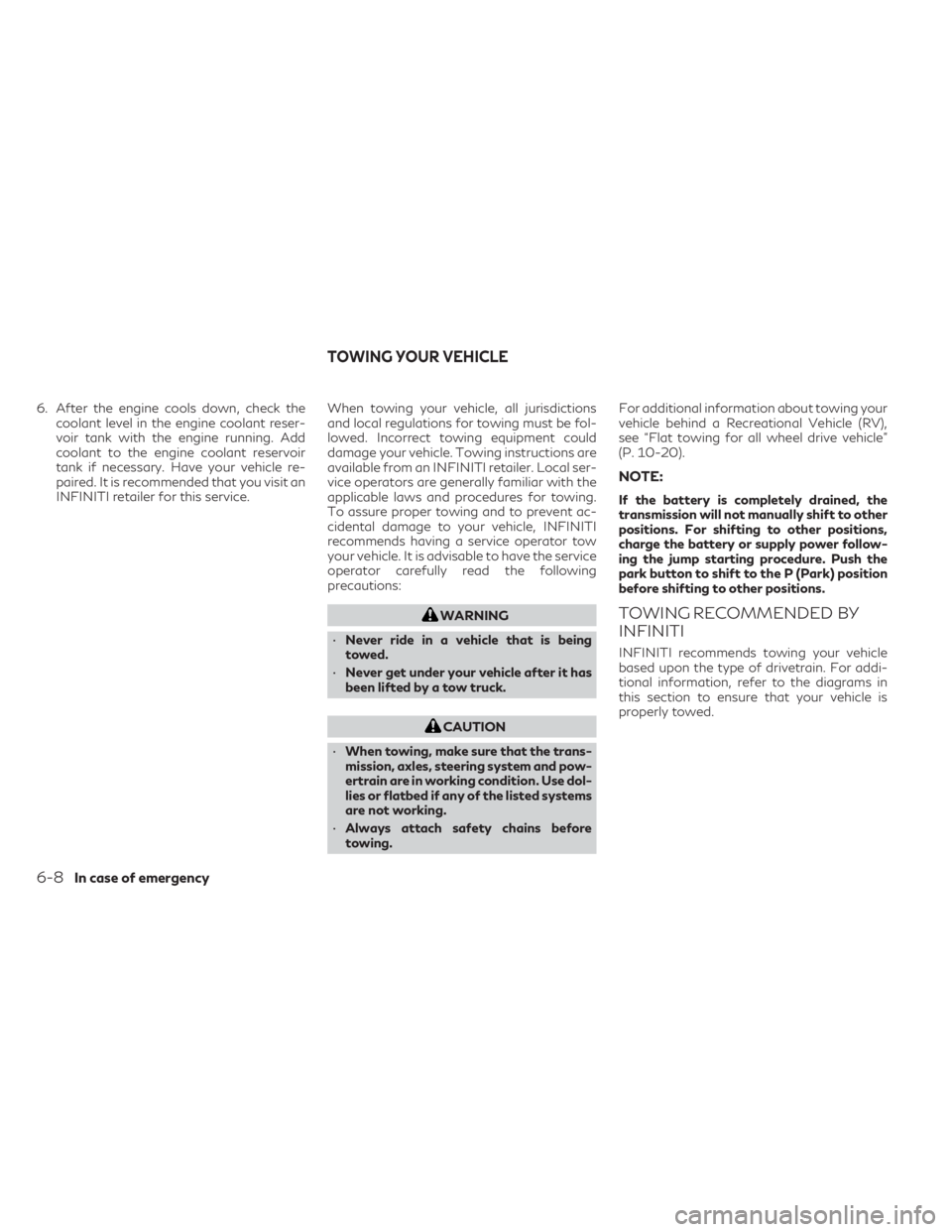
6. After the engine cools down, check thecoolant level in the engine coolant reser-
voir tank with the engine running. Add
coolant to the engine coolant reservoir
tank if necessary. Have your vehicle re-
paired. It is recommended that you visit an
INFINITI retailer for this service. When towing your vehicle, all jurisdictions
and local regulations for towing must be fol-
lowed. Incorrect towing equipment could
damage your vehicle. Towing instructions are
available from an INFINITI retailer. Local ser-
vice operators are generally familiar with the
applicable laws and procedures for towing.
To assure proper towing and to prevent ac-
cidental damage to your vehicle, INFINITI
recommends having a service operator tow
your vehicle. It is advisable to have the service
operator carefully read the following
precautions:
WARNING
• Never ride in a vehicle that is being
towed.
• Never get under your vehicle after it has
been lifted by a tow truck.
CAUTION
• When towing, make sure that the trans-
mission, axles, steering system and pow-
ertrain are in working condition. Use dol-
lies or flatbed if any of the listed systems
are not working.
• Always attach safety chains before
towing. For additional information about towing your
vehicle behind a Recreational Vehicle (RV),
see “Flat towing for all wheel drive vehicle”
(P. 10-20).
NOTE:
If the battery is completely drained, the
transmission will not manually shift to other
positions. For shifting to other positions,
charge the battery or supply power follow-
ing the jump starting procedure. Push the
park button to shift to the P (Park) position
before shifting to other positions.
TOWING RECOMMENDED BY
INFINITI
INFINITI recommends towing your vehicle
based upon the type of drivetrain. For addi-
tional information, refer to the diagrams in
this section to ensure that your vehicle is
properly towed.
TOWING YOUR VEHICLE
6-8In case of emergency
Page 421 of 526
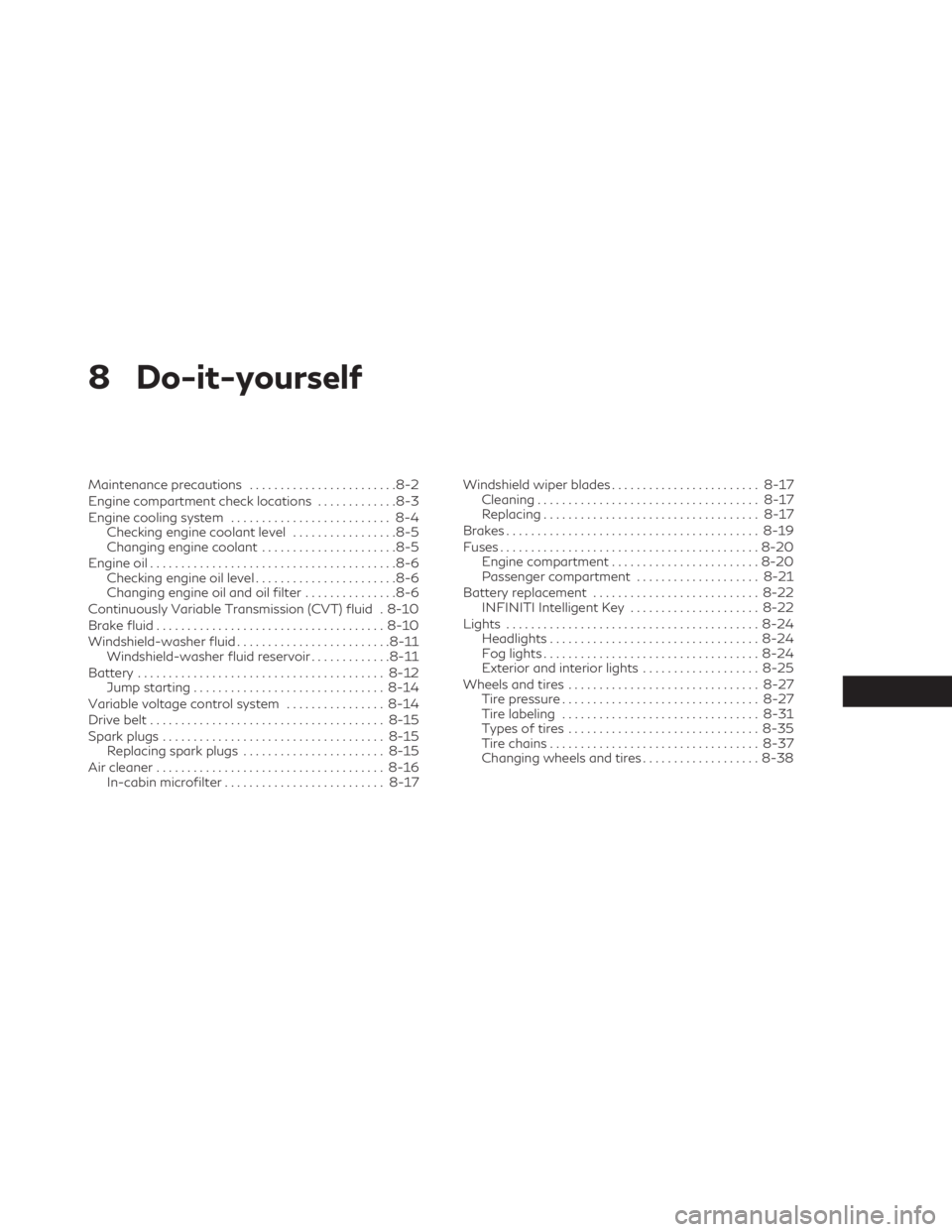
8 Do-it-yourself
Maintenance precautions........................8-2
Engine compartment check locations .............8-3
Engine cooling system .......................... 8-4
Checking engine coolant level .................8-5
Changing engine coolant ......................8-5
Engine oil ........................................8-6
Checking engine oil level .......................8-6
Changing engine oil and oil filter ...............8-6
Continuously Variable Transmission (CVT) fluid . 8-10
Brake fluid ..................................... 8-10
Windshield-washer fluid ......................... 8-11
Windshield-washer fluid reservoir .............8-11
Battery ........................................ 8-12
Jump starting ............................... 8-14
Variable voltage control system ................8-14
Drive belt ...................................... 8-15
Spark plugs .................................... 8-15
Replacing spark plugs ....................... 8-15
Air cleaner ..................................... 8-16
In-cabin microfilter .......................... 8-17Windshield wiper blades
........................ 8-17
Cleaning .................................... 8-17
Replacing ................................... 8-17
Brakes ......................................... 8-19
Fuses .......................................... 8-20
Engine compartment ........................ 8-20
Passenger compartment ....................8-21
Battery replacement ........................... 8-22
INFINITI Intelligent Key .....................8-22
Lights ......................................... 8-24
Headlights .................................. 8-24
Fog lights ................................... 8-24
Exterior and interior lights ...................8-25
Wheels and tires ............................... 8-27
Tire pressure ................................ 8-27
Tire labeling ................................ 8-31
Types of tires ............................... 8-35
Tire chains .................................. 8-37
Changing
wheels and tires ................... 8-38
Page 423 of 526
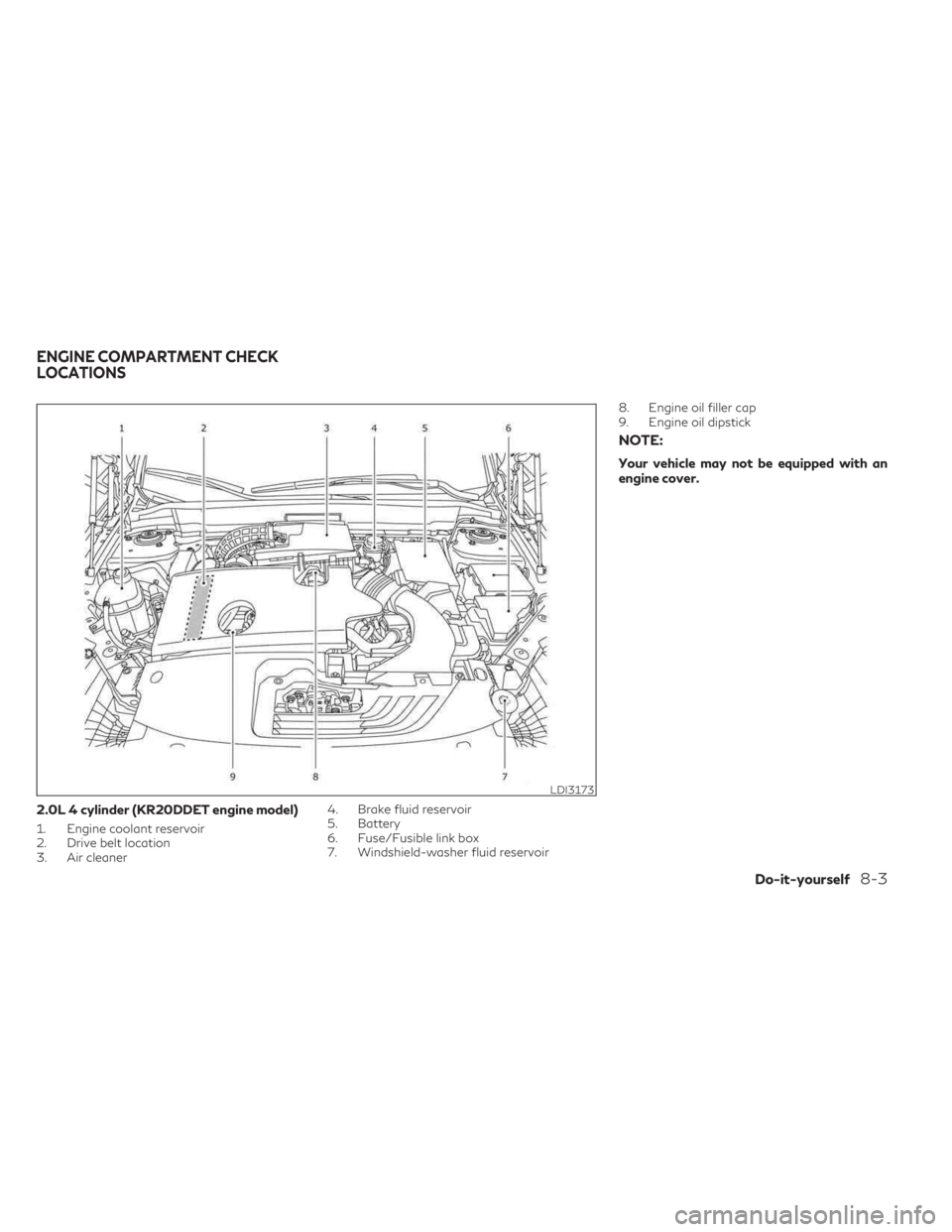
2.0L 4 cylinder (KR20DDET engine model)
1. Engine coolant reservoir
2. Drive belt location
3. Air cleaner4. Brake fluid reservoir
5. Battery
6. Fuse/Fusible link box
7. Windshield-washer fluid reservoir8. Engine oil filler cap
9. Engine oil dipstick
NOTE:
Your vehicle may not be equipped with an
engine cover.
LDI3173
ENGINE COMPARTMENT CHECK
LOCATIONS
Do-it-yourself8-3
Page 425 of 526

CHECKING ENGINE COOLANT
LEVEL
Check the coolant levelin the reservoir when
the engine is cold. If the coolant level is below
the MIN level
OB, add coolant to the MAX
level
OA. This vehicle contains Genuine NISSAN Long
Life Antifreeze/Coolant (blue). The life ex-
pectancy of the factory-fill coolant is
105,000 miles (168,000 km) or 7 years.
Mixing any other type of coolant or the use of
non-distilled water will reduce the life expec-
tancy of the factory-fill coolant. For addi-
tional information, see the “Maintenance and
schedules” section of this manual.
If the cooling system frequently requires
coolant, have it checked. It is recommended
that you visit an INFINITI retailer for this
service.
For additional information on the location of
the engine coolant reservoir, see “Engine
compartment check locations” (P. 8-3).
CHANGING ENGINE COOLANT
An INFINITI retailer can change the engine
coolant. The service procedure can be found
in the INFINITI Service Manual.
Improper servicing can result in reduced
heater performance and engine overheating.
WARNING
• To avoid the danger of being scalded,
never change the coolant when the en-
gine is hot.
• Never remove the coolant reservoir cap
when the engine is hot. Serious burns
could be caused by high pressure fluid
escaping from the radiator.
• Avoid direct skin contact with used cool-
ant. If skin contact is made, wash thor-
oughly with soap or hand cleaner as soon
as possible.
• Keep coolant out of the reach of children
and pets.
Engine coolant must be disposed of properly.
Check your local regulations.
LDI3157
Do-it-yourself8-5
Page 426 of 526

CHECKING ENGINE OIL LEVEL
1. Park the vehicle on a level surface andapply the parking brake.
2. Start the engine and let it idle until it reaches operating temperature.
3. Turn off the engine. Wait more than 10
minutes for the oil to drain back into the
oil pan.
4. Remove the dipstick and wipe it clean. Reinsert it all the way. 5. Remove the dipstick again and check the
oil level. It should be between the H (High)
and L (Low) marksOB. This is the normal
operating oil level range. If the oil level is
below the L (Low) mark
OA, remove the oil
filler cap and pour recommended oil
through the opening. Do not fill oil level
above H (High) mark
OC.
6. Recheck the oil level with the dipstick.
It is normal to add some oil between oil main-
tenance intervals or during the break-in pe-
riod, depending on the severity of operating
conditions.
CAUTION
Oil level should be checked regularly. Oper-
ating the engine with an insufficient
amount of oil can damage the engine, and
such damage is not covered by warranty.
CHANGING ENGINE OIL AND OIL
FILTER
For additional information on engine oil and
oil filter change, refer to the instructions out-
lined in this section.
Vehicle set-up
1. Park the vehicle on a level surface and apply the parking brake.
2. Run the engine until it reaches operating temperature.
3.
Turn the engine off and wait for 15 minutes.
4. Raise and support the vehicle using a suit- able floor jack and safety jack stands.
• Place the safety jack stands under the ve- hicle jack-up points.
• A suitable adapter should be attached to the jack stand saddle.
LDI3158LDI0371
ENGINE OIL
8-6Do-it-yourself